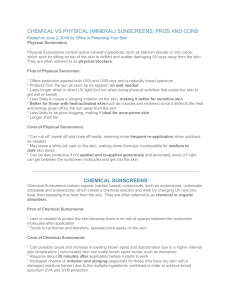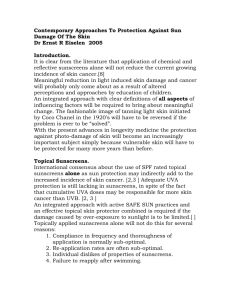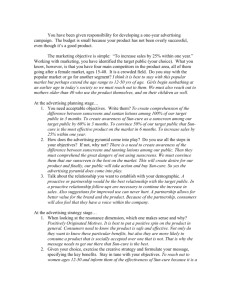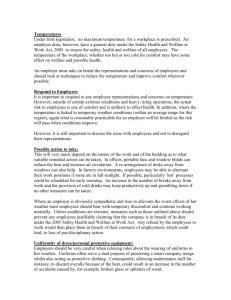Protection from skin damage due to visible light
advertisement
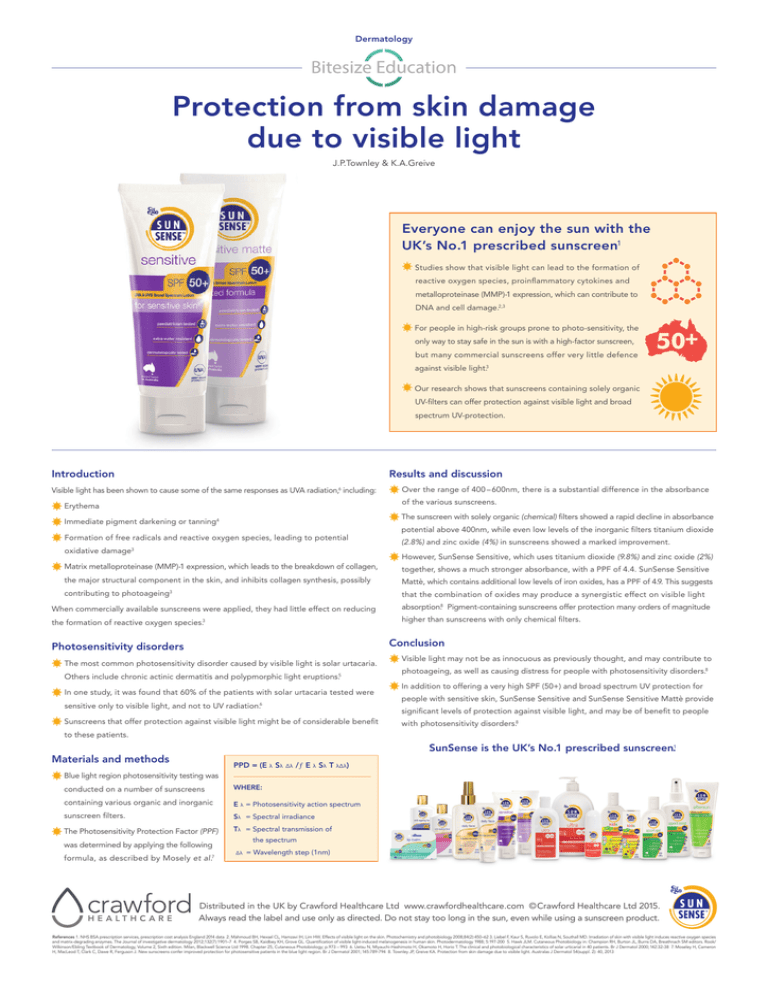
Dermatology Protection from skin damage due to visible light J.P.Townley & K.A.Greive Everyone can enjoy the sun with the UK’s No.1 prescribed sunscreen1 Studies show that visible light can lead to the formation of reactive oxygen species, proinflammatory cytokines and metalloproteinase (MMP)-1 expression, which can contribute to DNA and cell damage.2,3 For people in high-risk groups prone to photo-sensitivity, the only way to stay safe in the sun is with a high-factor sunscreen, but many commercial sunscreens offer very little defence 50+ against visible light.3 Our research shows that sunscreens containing solely organic UV-filters can offer protection against visible light and broad spectrum UV-protection. Introduction Results and discussion Visible light has been shown to cause some of the same responses as UVA radiation,6 including: Over the range of 400 – 600nm, there is a substantial difference in the absorbance of the various sunscreens. Erythema The sunscreen with solely organic (chemical) filters showed a rapid decline in absorbance Immediate pigment darkening or tanning4 Formation of free radicals and reactive oxygen species, leading to potential oxidative damage3 potential above 400nm, while even low levels of the inorganic filters titanium dioxide (2.8%) and zinc oxide (4%) in sunscreens showed a marked improvement. However, SunSense Sensitive, which uses titanium dioxide (9.8%) and zinc oxide (2%) Matrix metalloproteinase (MMP)-1 expression, which leads to the breakdown of collagen, together, shows a much stronger absorbance, with a PPF of 4.4. SunSense Sensitive the major structural component in the skin, and inhibits collagen synthesis, possibly Mattè, which contains additional low levels of iron oxides, has a PPF of 4.9. This suggests contributing to photoageing3 that the combination of oxides may produce a synergistic effect on visible light When commercially available sunscreens were applied, they had little effect on reducing absorption.8 Pigment-containing sunscreens offer protection many orders of magnitude the formation of reactive oxygen species.3 higher than sunscreens with only chemical filters. Conclusion Photosensitivity disorders The most common photosensitivity disorder caused by visible light is solar urtacaria. Others include chronic actinic dermatitis and polypmorphic light eruptions.5 In one study, it was found that 60% of the patients with solar urtacaria tested were sensitive only to visible light, and not to UV radiation.6 Sunscreens that offer protection against visible light might be of considerable benefit Visible light may not be as innocuous as previously thought, and may contribute to photoageing, as well as causing distress for people with photosensitivity disorders.8 In addition to offering a very high SPF (50+) and broad spectrum UV protection for people with sensitive skin, SunSense Sensitive and SunSense Sensitive Mattè provide significant levels of protection against visible light, and may be of benefit to people with photosensitivity disorders.8 to these patients. SunSense is the UK’s No.1 prescribed sunscreen.1 Materials and methods PPD = (E λ Sλ Δλ /ƒ E λ Sλ T λΔλ) Blue light region photosensitivity testing was conducted on a number of sunscreens Where: containing various organic and inorganic E λ = Photosensitivity action spectrum sunscreen filters. Sλ = Spectral irradiance The Photosensitivity Protection Factor (PPF) Tλ = Spectral transmission of was determined by applying the following formula, as described by Mosely et al.7 the spectrum ΔΔλ = Wavelength step (1nm) Distributed in the UK by Crawford Healthcare Ltd www.crawfordhealthcare.com ©Crawford Healthcare Ltd 2015. Always read the label and use only as directed. Do not stay too long in the sun, even while using a sunscreen product. References 1. NHS BSA prescription services, prescription cost analysis England 2014 data 2. Mahmoud BH, Hexsel CL, Hamzavi IH, Lim HW. Effects of visible light on the skin. Photochemistry and photobiology 2008;84(2):450–62 3. Liebel F, Kaur S, Ruvolo E, Kollias N, Southall MD. Irradiation of skin with visible light induces reactive oxygen species and matrix-degrading enzymes. The Journal of investigative dermatology 2012;132(7):1901–7 4. Porges SB, Kaidbey KH, Grove GL. Quantification of visible light-induced melanogenesis in human skin. Photodermatology 1988; 5:197-200 5. Hawk JLM. Cutaneous Photobiology in: Champion RH, Burton JL, Burns DA, Breathnach SM editors. Rook/ Wilkinson/Ebling Textbook of Dermatology, Volume 2, Sixth edition. Milan, Blackwell Science Ltd 1998. Chapter 25, Cutaneous Photobiology; p.973 – 993 6. Uetsu N, Miyauchi-Hashimoto H, Okamoto H, Horio T. The clinical and photobiological characteristics of solar urticarial in 40 patients. Br J Dermatol 2000; 142:32-38 7. Moseley H, Cameron H, MacLeod T, Clark C, Dawe R, Ferguson J. New sunscreens confer improved protection for photosensitive patients in the blue light region. Br J Dermatol 2001; 145:789-794 8. Townley JP, Greive KA. Protection from skin damage due to visible light. Australas J Dermatol 54(suppl. 2): 40, 2013
